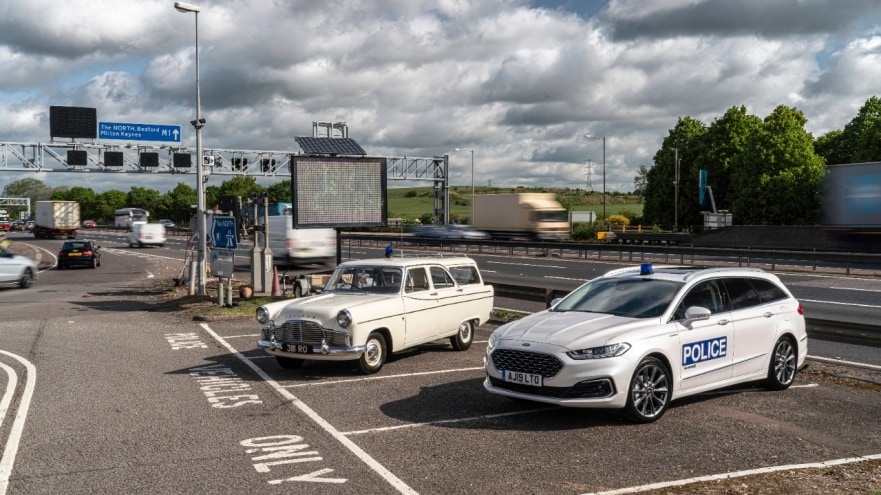- 2019 Ford Mondeo estate hybrid paired with 1959 Ford Zephyr police estate for M1 anniversary
- MkII Ford Zephyr is the only surviving police car to have patrolled the newly opened motorway
- Police Mondeo estate hybrid demonstrator self-charges on the move, produces only 99g CO2 and offers forces over 1,500 litre of load space for traffic units’ equipment
Ford brought new and old favourite police cars to the M1 to help celebrate 60 years of use on UK motorways.
With the original stretch of the higher speed trunk road running through Hertfordshire, Bedfordshire and Northamptonshire, the three counties’ police forces decided on a standard car to carry equipment quickly.
They picked Farnham’s conversion of the popular Ford Zephyr saloon into a versatile estate, and Herts Police’s car in Ford’s heritage collection is the only remaining example.
Forty years on, fleets are prioritising fuel efficiency and the Ford Mondeo large family estate now comes as a petrol-electric hybrid for the same price as the diesel only equivalent. It offers the driving range and freedom of a traditional combustion engine with the efficiency and refinement of an electric powertrain.
The self-charging engine, homologated at 99g CO2, eliminates both range anxiety and the need for customers to use an external power source to charge the battery.
The hybrid estate provides 403 litres load capacity beneath the tonneau cover with the rear seats in place, and up to 1,508 litres with the rear seats folded. The flat floor over the battery pack makes loading and unloading of large or bulky items easier, with additional storage under the load floor.
Owen Gregory, Ford of Britain fleet director, said: “The Ford Mondeo hybrid pulls away silently, produces zero emissions when running on electric and does not require plugging in to recharge.
“Factor in the estate’s extra space and this becomes the idea M1 motorway mile muncher for families and police fleets alike.”
Chris Smith, Highways England’s assistant safety coordinator for the East of England, said:
“Cars have changed beyond recognition in the last 60 years, and the motorways they drive on have too. Our first motorways had no speed limit, no safety barriers and many cars, which were not designed for motorway speeds, ended up on the hard shoulder.
“Today’s motorways are packed with technology to help people on their journeys, with variable speed limits to help smooth out stop-start traffic and signs and signals to warn drivers about changing conditions on the road ahead. On smart motorway sections, such as on the M1 between junctions 13 and 16, we’re making better use of the hard shoulder by making it available as an extra lane of traffic.
“Just as cars have changed over these past 60 years, we’re continuing to improve the motorway network to keep journeys smooth and safe for the millions of drivers who depend on them every day.”
# # #
How to drive safely and legally on England's smart motorways
Many parts of Highways England’s motorway network use technology to monitor and manage the flow of traffic. The technology is controlled from regional control centres which can activate and change signs and variable speed limits. This helps keep the traffic flowing more smoothly.
On some busier sections of motorways we temporarily open the hard shoulder or have converted it to a permanent extra lane so that more vehicles can travel, avoiding the expense and disruption of widening the road.
These technology-enabled sections of motorways have enhancements such as:
- electronic message signs that display Red X signs and variable speed limits
- sensors to monitor traffic volumes
- CCTV cameras
- emergency areas, with emergency roadside telephones
Quick tips
- Never drive in a lane closed by a Red X.
- Keep to the speed limits shown on the gantries or signs.
- A hard shoulder is always identified by a solid white unbroken line - if there’s no speed limit displayed above it or a Red X is displayed, do not use it except in emergency.
- A broken white line indicates a normal running lane.
- If the hard shoulder is being used as an extra lane, use the designated emergency areas for emergencies.
- If your vehicle experiences difficulties, eg warning light, exit the motorway immediately, if you can.
- If you break down, put your hazard lights on.
- Most breakdowns are preventable - keep your car well maintained, check your tyres and make sure you have enough fuel for your journey.
Video playlist: Highways England vehicle checks

